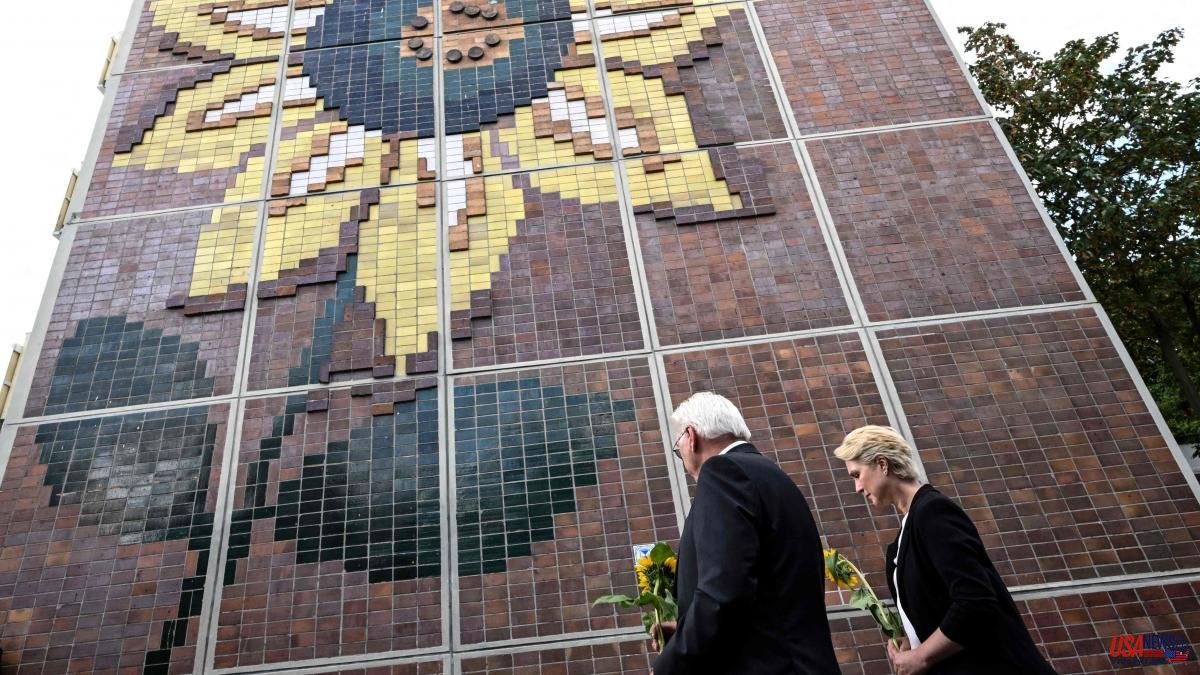The great lateral mosaic of sunflowers that thirty years ago dominated television news around the world, enveloped in the smoke and fire of xenophobic aggression, continues to dominate this block of flats in Rostock, a silent witness to events that caused shock and embarrassment in Germany, and whose memory is still being processed.
Between August 22 and 26, 1992, a mob of neo-Nazis attacked this building with stones and Molotov cocktails, which housed a reception center for asylum seekers and which also housed Vietnamese workers who had previously arrived with employment contracts. the former communist GDR.
"Anti-human hatred had taken hold in society," said Federal President Frank-Walter Steinmeier yesterday, who attended the 30th anniversary commemoration with Manuela Schwesig, President of the Land of Mecklenburg-Western Pomerania.
“We all remember the images of the flames coming out of the windows of the building, cruelly acclaimed by thousands of delirious people; but we can only imagine your fear of death, your feeling of abandonment,” Steinmeier said, addressing the victims at the ceremony. The head of state recalled that extreme right-wing violence still exists in Germany.
Despite its virulence, miraculously no one was killed in the Rostock events, as would happen in xenophobic arson attacks shortly afterwards. In November 1992 in Mölln (Schleswig-Holstein) three Turkish women died; and in May 1993 in Solingen (North Rhine-Westphalia) five Turks died. These two attacks, which took place in the Western Länder, invalidate the often put forward thesis that neo-Nazi violence is a problem above all in East Germany.
But there was an element in Rostock that, according to German anti-racist organizations, raised the “xenophobic riots” to another level, an element that historians often link to the concept of a pogrom: the applause of onlookers. And it was that that caused stupor inside and outside Germany.
Some 3,000 city residents turned out to watch the attack, and many cheered on the assailants, numbered around 300 individuals – local neo-Nazis or those from other cities – and hampered the work of police and firefighters. The agents also behaved passively at times, in part due to insufficient deployment. In any case, the use of the word pogrom, which emerged when Jews were persecuted in Czarist Russia, sparked controversy in Rostock.
In Lichtenhagen, the district where the ignominy occurred, the neighbors do not want to talk about it. On the first night of the attacks, almost all of the 2,000 gathered were from here.
The situation in that summer of 1992 was potentially explosive. The center for asylum seekers was overwhelmed; up to 600 people – most of them Romanian gypsies – camped out waiting. There was dirt and the neighbors were furious. Far-right sympathizers spread the word that they were going to act, but local and regional politicians either did not believe it or did not know or did not want to intervene in time.
On the third day, the attackers set fire to the building, in which, despite the evacuation, 120 Vietnamese remained –including children–, a team from German public television and the person in charge of asylum. They had to flee through the roof, from where they heard cries like "Germany for the Germans, foreigners out!"
There were hardly any convictions, or they were few and slight. Only three perpetrators were sentenced to prison; maximum, three years.
For Rostock, processing what happened –and overcoming the stigma– has been slow, and authorities and associations continue to do so, promoting debates and initiatives. In 2017, for the 25th anniversary, five memorials were installed in various places, one of them in front of the Sonnenblumenhaus; they are small, white cubicles that are difficult to repair.
For years, in addition, the analyzes abounded in evaluating the failures of the police and politicians and in investigating the reasons for the rage of the attackers. Now, finally, the perspective of the victims begins to take center stage.
Stefanie Oster, a historian at the local documentation project Lichtenhagen in Memory, believes that the ordeal of the victims was not taken into account because “in the beginning, the perpetrators of the violence received a lot of understanding, an attempt was made to understand why they had participated , and the debate was processed in such a way that the acts of violence by the population were analyzed as proof that a change in the asylum law was necessary”. Thus, the coalition government of conservatives and liberals led by Christian Democrat Chancellor Helmut Kohl reacted in May 1993 by tightening the asylum rules.













